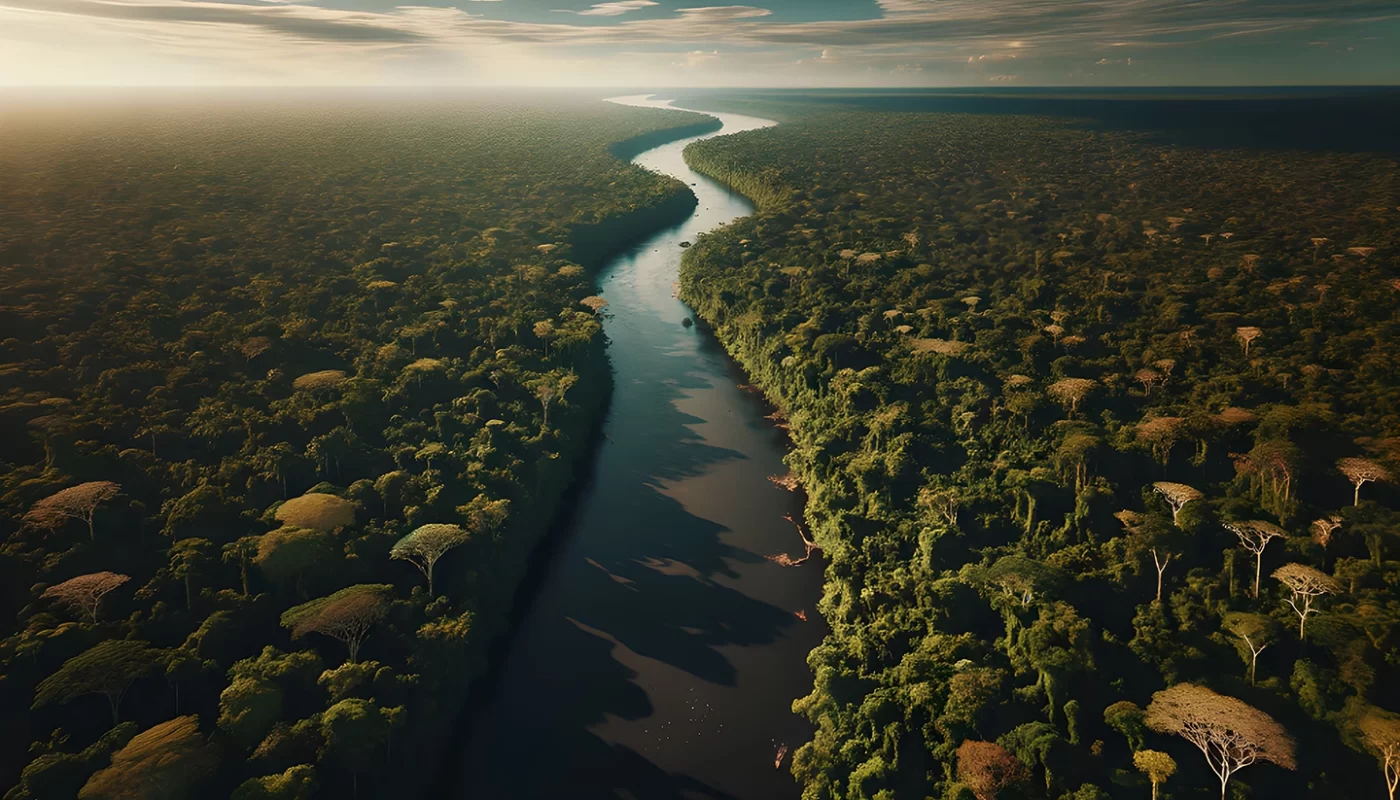Amazon River Facts, Environmental
The Amazon River – The Giver of Life of the Rainforest
Region: South America
Countries: Brazil, Colombia and Peru
Cities: Iquitos (Peru); Leticia (Colombia); Manaus (Brazil), Santarém and Belém do Pará (Brazil), Macapa (Brazil)
Tributaries: Marañón, Japurá/Caquetá, Rio Negro/Guainía, Putumayo (left); Ucayali, Purus, Madeira, Xingu, Tocantins (right) and so many more…
Primary Source: Andes Mountains (Peruvian Andes)
Primary Source Location: Nevado Mismi, Arequipa, Peru
Mouth Location: Atlantic Ocean
Length: 6,400 km
Width: 1.6 to 10 km at low stages (expanding to 48 km in wet season); 240 km (at the mouth – Atlantic Ocean)
Basin: 7,050,000 km2 (Approx.)
Average Discharge: 209,000 m3/s
The Amazon River, located in South America, is one of the most impressive natural features on Earth, renowned for its immense length, vast drainage basin, and crucial role in the world’s largest tropical rainforest ecosystem. Stretching approximately 6,400 kilometers, the Amazon is the second-longest river in the world, only slightly shorter than the Nile River in Africa. However, when considering its discharge volume and basin size, it surpasses all other rivers on the planet, making it the largest river by volume and the most important river system in South America.
Geographical Location and Origins
The Amazon River flows through three key South American countries: Peru, Colombia, and Brazil, and touches several major cities, including Iquitos in Peru, Leticia in Colombia, and Manaus, Santarém, Belém do Pará, and Macapá in Brazil. The river originates in the Peruvian Andes, specifically from the Nevado Mismi in the Arequipa region of Peru, which is considered the primary source of the river. This area lies high in the Andes Mountains, and from this point, the river begins its remarkable journey across the continent, flowing from west to east until it finally drains into the Atlantic Ocean along the coast of Brazil.
The Mouth Location of the river, where it empties into the Atlantic Ocean, is an enormous estuary, extending about 240 kilometers wide. At the point where it meets the ocean, the sheer force and volume of the water discharged by the Amazon make it a river like no other, earning it the nickname “The Sea River.” This term reflects not only the river’s immense size but also its significant influence on the surrounding geography, ecology, and weather patterns.
Tributaries and Basin
The Amazon River system is fed by numerous tributaries that contribute to its massive size and strength. Some of the major tributaries on the left side of the river include the Marañón, Japurá/Caquetá, Rio Negro/Guainía, and the Putumayo. On the right side, key tributaries include the Ucayali, Purus, Madeira, Xingu, and the Tocantins. Each of these tributaries plays a critical role in the river’s hydrology and the health of the surrounding ecosystems.
The river’s basin is the largest in the world, covering approximately 7,050,000 square kilometers. This basin accounts for about 30% of the landmass of South America and encompasses vast sections of tropical rainforest, wetlands, and floodplains. The Amazon Basin is a critical resource not only for the countries it touches but also for the entire planet, as it acts as a significant carbon sink, helping to regulate global climate by absorbing carbon dioxide from the atmosphere.
Length and Width
The length of the Amazon River is one of its defining characteristics, as it spans an astonishing 6,400 kilometers from its source in the Andes to its mouth at the Atlantic Ocean. This makes it only slightly shorter than the Nile, which is widely recognized as the longest river in the world. However, while the Amazon may not hold the title of the longest river, it holds the distinction of being the largest in terms of water flow. In fact, the average discharge of the Amazon is approximately 209,000 cubic meters per second, which is more than ten times the discharge of the Mississippi River in the United States.
In terms of width, the Amazon River varies dramatically depending on the season and location. During the dry season, the river can be as narrow as 1.6 kilometers at certain points, but in the rainy season, it can expand to a width of 48 kilometers in some areas. Near the river’s mouth, the width of the Amazon increases to approximately 325 kilometers, forming one of the largest river estuaries in the world. The changing width of the river is a result of the region’s fluctuating rainfall patterns, which cause the river to swell and recede on a seasonal basis.
History and Exploration
The Amazon River has a rich history that dates back thousands of years. It has long been home to various indigenous tribes who have relied on the river for transportation, food, and water. The river also holds a prominent place in the history of European exploration, particularly during the era of the Spanish and Portuguese conquests of South America.
In 1541, the Spanish explorer Francisco de Orellana became the first European to navigate the entire length of the Amazon River. Orellana’s journey was perilous, and he encountered numerous indigenous tribes along the way. In his accounts of the expedition, he reported coming into conflict with a tribe of female warriors, whom he likened to the Amazons from Greek mythology. Based on this encounter, Orellana named the river “Amazon”, a name that has stuck ever since. While modern historians debate the accuracy of Orellana’s accounts, the name remains an enduring symbol of the river’s wild and untamed nature.
Ecology and Biodiversity
The Amazon River is at the heart of the Amazon Rainforest, the largest tropical rainforest in the world. This ecosystem is one of the most biodiverse regions on Earth, home to an estimated 390 billion individual trees belonging to about 16,000 species. The forest is also home to countless species of animals, many of which are found nowhere else in the world. The Amazon Basin supports a rich array of wildlife, including jaguars, sloths, tapirs, capybaras, and various species of monkeys. The river itself is home to a diverse range of aquatic life, including the Amazon River dolphin, also known as the pink dolphin, as well as piranhas, electric eels, and giant otters.
The Amazon’s immense size and ecological diversity make it a critical habitat for numerous species, many of which are still being discovered by scientists today. However, this delicate ecosystem is under threat from deforestation, climate change, and human activities, which have caused significant damage to the rainforest in recent decades. Despite these challenges, conservation efforts are underway to protect the Amazon and ensure that it continues to serve as a vital resource for future generations.
Importance to Local Communities
For the indigenous peoples who have lived along the Amazon River for millennia, the river is more than just a physical feature of the landscape; it is a lifeline. The river provides fresh water, fish, and a means of transportation for communities that are often isolated from modern infrastructure. Traditional knowledge of the river and its ecosystem has been passed down through generations, and many indigenous tribes have developed sustainable ways of living in harmony with the river and the forest.
In addition to its importance to indigenous communities, the Amazon River also plays a vital role in the economies of Peru, Colombia, and Brazil. The river serves as a major transportation route for goods and people, particularly in areas where roads are scarce or nonexistent. In Brazil, the city of Manaus, located in the heart of the Amazon Rainforest, has become a key hub for trade and commerce, largely due to its proximity to the river.
Environmental Challenges
Despite its immense natural beauty and ecological importance, the Amazon River faces numerous environmental challenges. Deforestation is perhaps the most pressing issue, as large swathes of the Amazon Rainforest are being cleared for agriculture, logging, and mining. This deforestation has led to habitat loss for countless species and has contributed to climate change by reducing the forest’s ability to absorb carbon dioxide.
In addition to deforestation, the Amazon River is also threatened by pollution and dams. Agricultural runoff, mining waste, and plastic pollution have all contributed to the degradation of the river’s water quality, posing a risk to both wildlife and local communities. The construction of dams along the river and its tributaries has also disrupted the natural flow of the river, affecting fish migration patterns and altering the ecosystem.
The Amazon River is one of the most iconic and important natural features in the world. Its vast size, rich biodiversity, and critical role in the South American ecosystem make it a river of unparalleled significance. From its origins in the Peruvian Andes to its mouth in the Atlantic Ocean, the Amazon River has shaped the history, culture, and economy of the region for centuries.
As the world faces growing environmental challenges, the protection and preservation of the Amazon River and its surrounding rainforest have never been more critical. Efforts to conserve this vital ecosystem are essential not only for the people and wildlife who call the Amazon home but also for the health of the planet as a whole. The Amazon River truly is a river of life, and its continued existence is key to maintaining the delicate balance of nature on Earth.


